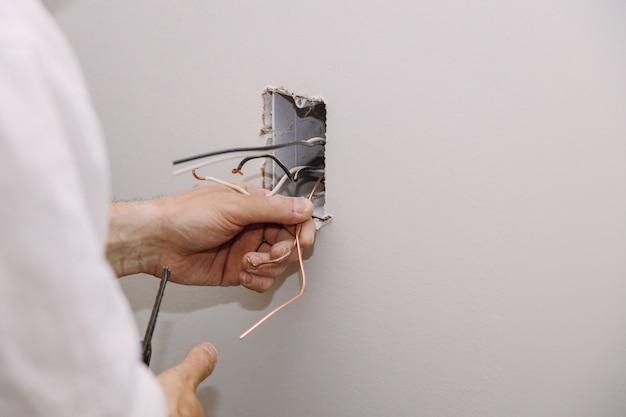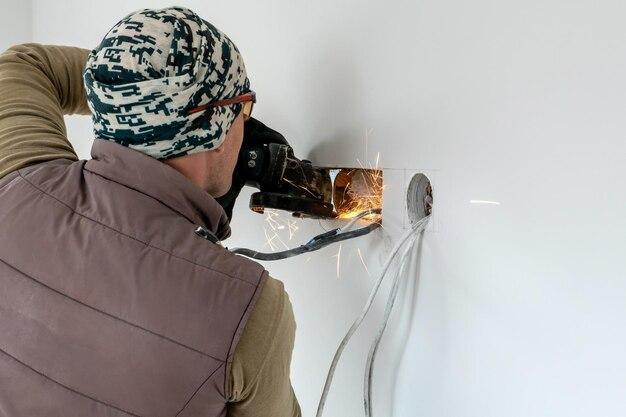Welcome to our blog post on how to install electrical outlets in an unfinished basement. Whether you’re planning to transform your basement into a cozy living space or a functional home office, having adequate electrical outlets is essential for powering your devices and appliances. In this guide, we will walk you through the process of adding electrical outlets to your unfinished basement.
If you’re wondering about the cost, wiring methods, electrical codes, or any other related questions, we’ve got you covered. We will also address common concerns such as the need for GFCI outlets, the types of electrical boxes required, and the recommended spacing between outlets. Plus, we’ll provide answers to frequently asked questions regarding wiring your basement and the necessary circuits.
So, if you’re ready, let’s dive into the world of electrical installations in an unfinished basement and turn that blank canvas into a well-wired space that meets your electrical needs.
How to Easily Install Electrical Outlets in Your Unfinished Basement
So, you’ve finally decided to tackle the project of finishing your basement. Congratulations! Now, one of the crucial steps in making your basement a livable space is understanding how to properly install electrical outlets. After all, no one wants to stumble around in the dark like a clumsy ninja.
Determining the Ideal Outlet Locations
Before we dive into the actual installation process, let’s talk about placement. You don’t want to install your outlets willy-nilly, only to discover later that your strategic furniture arrangement is hindered by their awkward positioning. So, grab your sketchbook and envision the best setup for your basement, taking into account future use as well.
Mapping Out the Wiring
Now that you have envisioned the perfect outlet spots, it’s time to map out the wiring. This is where IT nerds rejoice! Plan the pathways for your electrical wires, keeping in mind that safety and code compliance are essential. No need to go all Da Vinci on this, a simple sketch will do.
Safety First, DIY Second
Before you embark on this electrifying adventure, make sure to turn off the power supply to the basement. This is not the time to prove your superpowers, my friend. Locate your circuit panel and switch off the corresponding breaker. Better safe than sorry, because we all know electrocution is not a pleasant surprise.
Tools of the Trade
Now, let’s gather up our tools like diligent scouts preparing for a wild adventure. You’ll need a voltage tester, wire strippers, a drill with a long bit, electrical tape, wire connectors, and of course, the star of the show – the brand spanking new electrical outlets. Get ready to rock that tool belt!
Time to Get Wired
With your tools at the ready, it’s time to get down and dirty with some electrical work. Start by removing the cover of the existing electrical box, making sure it is securely mounted to the wall. Now, time to don your superhero cape (and safety goggles) and connect the wires. Remember, black goes with black, white with white, and the ground wire should be green, like your basil smoothie.
Secure and Rejoice
Once the wires are connected, gently tuck them back into the electrical box, being careful not to cramp their style. Secure the electrical outlet to the box, making sure it feels snug. Give it a little pat and whisper, “You’re doing great, sweet outlet.”
Test Your Handiwork
Before you break out the celebratory donuts, you need to make sure everything is working smoothly. Switch the breaker back on, and with a hint of suspense, test the outlet with your favorite electrical device. Ta-da! If the power flows like a freshly brewed cup of coffee, congratulations! You, my friend, have successfully installed an electrical outlet in your unfinished basement.
Rinse and Repeat (But Not Literally)
Now that you’ve conquered the first outlet, rinse and repeat the process for the remaining ones. Remember to space them out strategically, ensuring optimal happiness and functionality. Soon, your basement will be illuminated, charging your future game nights and Netflix binges with a flick of a switch.
So there you have it, folks! A comprehensive guide on how to install electrical outlets in your unfinished basement. With the right tools, a bit of caution, and a sprinkle of humor, you’ll be enjoying a well-lit basement in no time. Happy DIYing, and remember, don’t be shocked if your friends start asking you for advice on their own basement projects!
FAQ: How To Install Electrical Outlets In an Unfinished Basement
Are you looking to add electrical outlets to your unfinished basement? This FAQ-style guide has got you covered! We’ve compiled a list of commonly asked questions about installing electrical outlets in an unfinished basement and provided clear and concise answers to help you navigate the process with ease. So, let’s get started!
How much does it cost to add electrical outlets in a basement
The cost of adding electrical outlets in a basement can vary depending on several factors, such as the number of outlets needed, the accessibility of the wiring, and the local labor rates. As of 2023, you can expect to pay an average of $150 to $250 per outlet, including the installation and materials.
How do you run electrical wire in an unfinished basement
To run electrical wire in an unfinished basement, you’ll need to follow specific guidelines to ensure safety and compliance. Firstly, you’ll need to determine the path for the wiring, which often involves running it along the ceiling joists or through conduit pipes. It’s essential to consult local building codes and regulations, as they may dictate specific requirements for wire placement and protection.
Can you add electrical outlets to an unfinished basement
Absolutely! Adding electrical outlets to an unfinished basement is an excellent way to enhance functionality and convenience. Whether you’re planning a workshop, a home office, or a cozy entertainment space, strategically placed outlets can make a significant difference in the usability of your basement.
How do you run Romex in an unfinished basement
Running Romex (Non-Metallic Sheathed Cable) in an unfinished basement is a common method used for electrical wiring. It’s essential to secure the Romex cable to the framing members using approved staples or straps. In certain situations, the local building codes may require additional protective measures, such as conduit or armored cable, so always check the regulations in your area.
How much do GFCI outlets cost
GFCI (Ground Fault Circuit Interrupter) outlets are designed to protect you from electrical shock by quickly shutting off power if an imbalance is detected. As of 2023, you can expect to pay around $15 to $40 per GFCI outlet, depending on the brand and features. While the initial cost may be slightly higher than standard outlets, the added safety is well worth the investment.
Do basement outlets need to be GFCI
According to the National Electrical Code (NEC), GFCI protection is required for electrical outlets in unfinished basements. This includes outlets located within six feet of a sink or utility tub or any outlets serving countertop surfaces. GFCI protection helps mitigate the risk of electrical shock, making it a crucial safety measure for basements and other areas where moisture may be present.
What kind of electrical box do I need for a basement
When it comes to electrical boxes for basements, you’ll need to choose the right type based on your specific needs. A standard plastic or metal electrical box will suffice for most applications. However, if you’re installing outlets near water sources or in damp areas, consider using a waterproof or weather-resistant electrical box for added protection.
What is the code for outlets in a basement
The specific electrical code requirements for outlets in a basement may vary slightly depending on your location. However, as a general rule, electrical outlets should be installed no more than six feet apart along the walls. Additionally, GFCI protection is required for all outlets in an unfinished basement, as we mentioned earlier.
How far apart do electrical outlets have to be
According to electrical code guidelines, electrical outlets should generally be spaced no more than 12 feet apart along the wall in living areas. However, in areas where furniture may be arranged differently, you may need to adjust the spacing to ensure convenient access to outlets.
Can I mix 12 gauge and 14 gauge wire
It’s essential to use the same gauge (thickness) of wire throughout a single electrical circuit. Mixing 12 gauge and 14 gauge wire is not recommended, as it can lead to potential hazards, such as overheating or electrical fires. Always follow the manufacturer’s recommendations and consult local electrical codes when determining the appropriate wire gauge for your project.
Can I install an electrical outlet myself
If you have experience working with electrical systems and feel confident in your abilities, you can install an electrical outlet in your basement yourself. However, it’s important to emphasize that electrical work can be dangerous and complicated, so it’s always best to hire a licensed electrician if you have any doubts or concerns.
Can I wire my basement myself
Similar to installing an electrical outlet, wiring a basement yourself is possible if you possess the necessary electrical knowledge and skills. However, keep in mind that electrical work must adhere to specific codes and regulations, and any mistakes or oversights can have serious consequences. It’s generally recommended to hire a professional electrician to ensure the job is done safely and up to code.
How many circuits do I need for a basement
The number of circuits needed for a basement depends on the electrical load requirements of the space. It’s best to consult with a licensed electrician who can assess your specific needs to determine the appropriate number of circuits. Factors such as lighting, outlets, appliances, and any specialized equipment should all be considered.
How many receptacles are required in an unfinished basement
Building codes often require a certain number of electrical receptacles in unfinished basements. As a general guideline, outlets should be installed at least every 12 feet along the walls. However, it’s crucial to check your local codes for any specific requirements or variations.
What is the minimum height for an electrical outlet
According to electrical codes, the minimum height for an electrical outlet in an unfinished basement is 12 inches above the floor. This height ensures that the outlet remains accessible while minimizing the risk of potential water damage.
Do I need a subpanel in my basement
The need for a subpanel in a basement depends on the electrical load demand and the existing main electrical panel’s capacity. If you plan to add multiple circuits or have a significant power requirement in your basement, a subpanel may be necessary to accommodate the additional electrical load. Consult with an electrician to assess your specific needs.
Do outlets need to be grounded
Yes, outlets in an unfinished basement must be grounded for safety purposes. Grounding helps prevent electrical shock and diverts electrical energy safely into the ground. Be sure to follow the proper wiring practices to ensure all outlets are correctly grounded in accordance with local electrical codes.
Now that you have a comprehensive understanding of how to install electrical outlets in an unfinished basement, you’re ready to take on this project with confidence. Remember to prioritize safety, consult with professionals when needed, and adhere to local electrical codes and regulations. Happy wiring!

